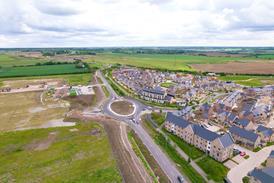Matt Jones explains why weatherproofing penetrations is a vital but often overlooked part of Building Safety Act compliance – and how early specialist involvement can save contractors time, money and risk

The Building Safety Act (BSA) 2022 aims to ensure all buildings – especially high-risk ones – are designed, constructed and managed to protect occupants. It covers every element of construction, including weatherproofing.
The BSA introduced three gateways covering planning, pre-construction and pre-occupation. Weatherproofing must be considered at every stage, starting at design. Materials should meet regulatory standards and project-specific needs; installation must be rigorous to ensure long-term performance; and due diligence is needed to confirm sub-contractors are competent, accredited and have tested any proprietary systems.
Poor weatherproofing can compromise both the structural integrity and fire safety of a building. This is particularly critical for high-risk buildings under the BSA – such as high-rise mixed-use developments, hospitals or mission-critical facilities like data centres.
If penetrations are not weatherproofed effectively, water ingress can cause mould affecting occupant health and corrosion that undermines structural security. It can also damage fire-resistant materials such as coatings and cladding. If weakened, these materials provide less protection against flames and heat, increasing the risk of rapid fire spread or structural failure.
Breaches in weatherproofing can also create pathways for smoke and flames to bypass safety barriers. Meanwhile, water-damaged load-bearing elements may fail sooner in a fire, undermining the fire resistance strategy designed to give occupants time to evacuate safely.
If a specialist weatherproofing contractor has not been engaged at design stage, principal contractors can still mitigate risk by bringing one in early once appointed. The right specialist will:
- Work closely with the design team to understand objectives and develop bespoke solutions for penetrations
- Ensure compliance with national standards such as BS 8102:2022
- Compile the technical information needed to maintain the Golden Thread
- Blend weatherproofing around complex penetrations with the building’s aesthetics while preventing water ingress in basements or around cable trays – without compromising fire safety.
Specialist subcontractors can also fabricate solutions on site, allowing for last-minute positional changes without disrupting other trades or delaying schedules. This clarifies liability, speeds delivery and ensures work is backed by a warranty.
Weatherproofing may not be the first thing contractors think about under the BSA, but its role in maintaining structural integrity, safeguarding fire protection and ensuring compliance cannot be overstated. Early engagement with a specialist for penetrations reduces risk, prevents costly remedial work and delivers buildings that are safe, durable and attractive for years to come.
Matt Jones is commercial director at Jones Weatherproofing



























No comments yet